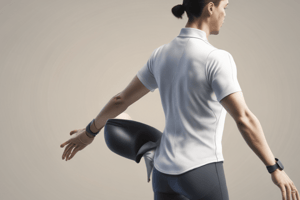Podcast
Questions and Answers
What should be the position of the pinna during a physical examination of the ear?
What should be the position of the pinna during a physical examination of the ear?
What color should the tympanic membrane appear as during an ear examination?
What color should the tympanic membrane appear as during an ear examination?
What does localized swelling around the ear during a physical assessment indicate?
What does localized swelling around the ear during a physical assessment indicate?
What is considered an abnormal finding during an ear assessment?
What is considered an abnormal finding during an ear assessment?
Signup and view all the answers
What might cause the eardrum to collapse, leading to barotrauma?
What might cause the eardrum to collapse, leading to barotrauma?
Signup and view all the answers
Which of the following is NOT a normal feature to observe during a physical examination of the ear?
Which of the following is NOT a normal feature to observe during a physical examination of the ear?
Signup and view all the answers
What is a potential consequence for newborns who test positive for direct Coombs antibody?
What is a potential consequence for newborns who test positive for direct Coombs antibody?
Signup and view all the answers
Why is examination of the sclera and buccal mucosa important in newborns?
Why is examination of the sclera and buccal mucosa important in newborns?
Signup and view all the answers
What should be considered if variations such as ear spacing, palpebral fissure size, and skin tags are detected?
What should be considered if variations such as ear spacing, palpebral fissure size, and skin tags are detected?
Signup and view all the answers
What role do nurses play in the management of ear disorders according to the text?
What role do nurses play in the management of ear disorders according to the text?
Signup and view all the answers
Why is it important to promptly evaluate abnormal findings in the ear?
Why is it important to promptly evaluate abnormal findings in the ear?
Signup and view all the answers
What do variations in ear features such as ear spacing indicate unless associated with other anomalies?
What do variations in ear features such as ear spacing indicate unless associated with other anomalies?
Signup and view all the answers
Study Notes
Physical Assessment of the Ear
Performing a comprehensive physical assessment of the ear involves identifying both normal and abnormal features. These assessments are crucial for detecting ear infections and other complications early on, ensuring prompt intervention if needed. Here's what to look out for during a physical examination of the ear:
Normal Features
- Shape: The outer ear, or pinna, should be symmetrical and positioned normally. They should not be too low-set or too high-set.
- Position: The pinna should be relaxed and facing forward.
- Color: The skin color of the pinna should match that of surrounding skin tone.
- Tympanic Membrane: Upon using an otoscope, the tympanic membrane should appear grayish-white and slightly translucent. Some vascularization is normal.
Abnormal Findings
- Aborrations: Any cuts, bruises, or abrasions around the ear would be considered abnormal.
- Swelling: Localized swelling could indicate fluid accumulation due to infection or inflammation.
- Redness: The ear canal and the surface of the tympanic membrane may become red in response to infection or inflammation.
- Collapsed Tympanic Membrane: In some cases, the eardrum can collapse from severe pressure changes, like those experienced during air travel or scuba diving. This is known as barotrauma.
Pathology Associated With Ear Assessment Findings
1. Coombs Test Positive Newborns
Newborns who test positive for direct Coombs antibody have a higher risk of developing jaundice due to hemolytic disease of the newborn (HDN). Examination of the sclera and buccal mucosa is essential in detecting early signs of jaundice.
2. Normal Variations
Variations such as ear spacing, palpebral fissure size, and skin tags are normal unless associated with other anomalies. If any abnormality is detected, it's crucial to consider possible genetic factors and the likelihood of hearing loss or renal issues associated with these variations.
Conclusion
Conducting a thorough physical assessment of the ear involves identifying both normal and abnormal features. Abnormal findings should be promptly evaluated by healthcare professionals to ensure timely intervention if necessary. By understanding normal anatomy, recognizing pathologic conditions, and knowing when to refer patients for further diagnostic testing or procedures, nurses play a vital role in ensuring proper treatment and management of ear disorders.
Studying That Suits You
Use AI to generate personalized quizzes and flashcards to suit your learning preferences.
Description
Learn about conducting a comprehensive physical assessment of the ear, identifying normal and abnormal features, and recognizing pathologies associated with ear assessment findings. Explore how to detect abnormalities, such as swelling, redness, and collapsed tympanic membrane, as well as understanding pathology like Coombs Test Positive in newborns.




